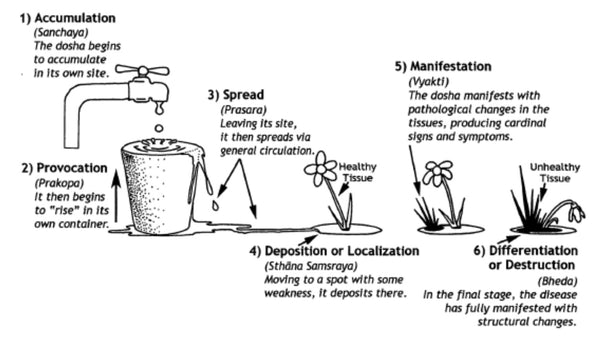-
SHOP
- Software
-
Services
-
MORE
June 05, 2020
Ayurveda speaks of the six-stage progression of disease. This approach allows effective strategies to be implemented to restore health and harmony in body and mind.
Disease begins with simple and seemingly insignificant disturbances in the body that affect the symbiotic relationship between the mind (origin of most imbalances) and digestion (origin of most physical imbalances). This usually occurs in these six stages:

(Image from “Textbook of Ayurveda, Vol. 1: Fundamental Principles of Ayurveda” by Vasant Lad)
Accumulation - Due to poor digestion, Ama (= undigested substance / toxins) is generated. Mild symptoms may be perceived, but they usually subside quickly and without discomfort.
Provocation / Aggravation - When ama continues to accumulate, aggravation of specific areas of the digestive tract begins. Consequences: gas, bloating, hyperacidity, constipation, soft or irregular bowel movements.
Spread / Migration - Eventually, ama and dosha imbalance overflow from the areas where they have accumulated and pass through the intestinal wall into the circulation channels. Ama and dosha imbalance at this stage can lead to a disruption of beneficial intestinal bacteria or conditions such as intestinal leakage/hyperpermeability. Consequences: Disruption of various functions such as immunity, metabolism and blood sugar regulation.
Deposit / localization - Eventually, the imbalance of ama and dosha begins to settle in the weakest areas/systems and accumulates over time. Consequences: pain, stiffness, inflammation, swelling and slight tissue dysfunction. For example: acne, arthritis, over time: autoimmune disease.
The body can, to some extent, eliminate some of these toxins, but usually not fast enough if the ama/toxins are still being created. Intrinsic/emunctory detoxification pathways may already be compromised by genetic or environmental factors. The body then begins to aggressively attack the ama, resulting in local tissue damage.
Manifestation - Over time, these alterations weaken the sites of deposition. Consequences: The structure and function of the tissues/organ are now seriously disrupted. Signs and symptoms clearly associated with specific diseases are visible for diagnosis.
Differentiation, destruction, disruption, chronicity or complication - If the primary cause is not addressed, the pathology becomes more complex and usually leads to secondary conditions. It then becomes much more difficult to treat or manage the situation. Consequences: surgery or powerful pharmaceutical drugs with harmful side effects that lead to complications in other areas.
Looking at health from this perspective, it is clear that it is important to maintain a healthy mind, body and emotions. As a practitioner, it is essential to understand what stage a person is at and to make them aware of the importance of restoring a balanced and healthy environment.
It’s interesting that one of the first things Bernard Jensen talks about in his book “Iridology Simplified” is the disease dégeneration stages (link). My simplified understanding of this is: How deeply has the imbalance affected the person’s health? 1) Acute, 2) Subacute, 3) Chronic and 4) Degenerative

So much more could be said on this topic. Would you like me to go deeper on this?
Would you like more information on similar subjects?
This newsletter is for your benefit so please share your comments and questions and I’ll cover them soon. Also if you are struggling with a difficult case, please share the details, anonymously, and I can look at it with another pair of holistic eyes.
Due to the different lockdown measures, there has been a number of delays in our work. With our manufacturer, we have negotiated a reduced price on the delayed batch of units. (limited to 19 units).
We're also preparing something special for recent clients that experienced delays. There's also something for everyone.
Comments will be approved before showing up.
